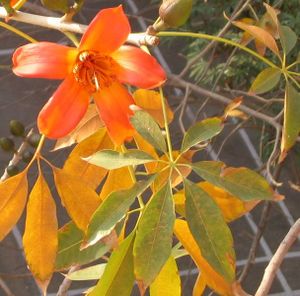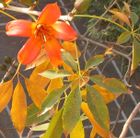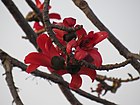Note: This is a project under development. The articles on this wiki are just being initiated and broadly incomplete. You can Help creating new pages.
Difference between revisions of "Bombax ceiba - Kutasalmali"
(Created page with "thumb|right|''Shalmali'', ''Silk Cotton Tree'' Shalmali is a genus of mainly tropical trees in the mallow family. They are native to western A...") |
(→External Links) |
||
| (44 intermediate revisions by 4 users not shown) | |||
| Line 1: | Line 1: | ||
[[File:Bombax-flower-leaf.jpg|thumb|right|''Shalmali'', ''Silk Cotton Tree'']] | [[File:Bombax-flower-leaf.jpg|thumb|right|''Shalmali'', ''Silk Cotton Tree'']] | ||
| + | '''Bombax ceiba''' is a medicinal tree and is also referred as silent doctor. It is found in India, Malaysia, Sri lanka, Hong kong, Australia and Africa. Every part of this tree is used to treat various ailments. | ||
| + | ==Uses== | ||
| + | {{Uses|Semen problems}}, {{Uses|Leucorrhoea}}, {{Uses|Over bleeding in menstruation}}, {{Uses|Acne}}, {{Uses|Skin blemish}}, {{Uses|Pigmentation}}, {{Uses|Wounds}}, {{Uses|Cold}}, {{Uses|Sore throats}}, {{Uses|Cough}}<ref name="Karnataka Medicinal Plants"/> | ||
| − | + | ===Food=== | |
| + | Bombax ceiba can be used in food. Young roots are roasted over fi re and eaten. Flower buds and fruits are cooked as vegetable, petals used in | ||
| + | preparation of jam<ref name="Forest foods of Western Ghat"/>. | ||
| − | + | ==Parts Used== | |
| + | {{Parts Used|Flower}}, {{Parts Used|Leaf}}, {{Parts Used|Root}}, {{Parts Used|Bark}}<ref name="Karnataka Medicinal Plants"/> | ||
| − | + | ==Chemical Composition== | |
| + | Stem and root bark contains lupeol, β-sitosterol, naphthoquinone compound, phenolic substances, a lactone, 4 sesquiterpenes. Root yields triacontanol, β- sitosterol.<ref name="chemical composition"/> | ||
| − | + | ==Common names== | |
| + | {{Common names|kn=Marahatti, Kempu booruga|ml=Unnamurika|sa=Shalmali, Semul, Simul|ta=Sittan, Sanmali|te=Buruga|hi=Shalmali|en=Silk Cotton Tree, Kapok Tree}} | ||
| + | ==Properties== | ||
| + | Reference: Dravya - Substance, Rasa - Taste, Guna - Qualities, Veerya - Potency, Vipaka - Post-digesion effect, Karma - Pharmacological activity, Prabhava - Therepeutics. | ||
| + | ===Dravya=== | ||
| + | |||
| + | ===Rasa=== | ||
| + | Kashaya (Astringent) | ||
| + | ===Guna=== | ||
| + | Laghu (Light), Snigda (haevy) | ||
| + | ===Veerya=== | ||
| + | Sheeta (cold) | ||
| + | ===Vipaka=== | ||
| + | Madhura (Sweet) | ||
| + | ===Karma=== | ||
| + | |||
| + | ===Prabhava=== | ||
| + | |||
| + | ===Nutritional components=== | ||
| + | Kutasalmali contains the Following nutritional components like Vitamin-A, C and E; Calcium, Iron, Magnesium, Potassium, Phosphorus, Sodium<ref name="Forest foods of Western Ghat"/> | ||
| + | |||
| + | ==Habit== | ||
| + | {{Habit|Deciduous tree}} | ||
| + | |||
| + | ==Identification== | ||
| + | ===Leaf=== | ||
| + | {{Leaf|Simple|Digitate|Leaf Shape is Oblong-lanceolate or elliptic and Leaf Arrangement is Alternate -spiral}}<ref name="Leaf"/> | ||
| + | |||
| + | ===Flower=== | ||
| + | {{Flower|Unisexual|2-4cm long|Yellow|5-20|Solitary, paired or clustered; blood red. Flowering from April-March}} | ||
| + | |||
| + | ===Fruit=== | ||
| + | {{Fruit|Oblong capsule|7–10 mm|Fruiting April onwards|A loculicidal, oblong capsule, 5-valved|Many}} | ||
| + | |||
| + | ===Other features=== | ||
| + | |||
| + | ==List of Ayurvedic medicine in which the herb is used== | ||
| + | [[Shalmali ghrita]], [[Chandanasava]], [[Himasagara tailam]], [[Vigorex]], [[Gangadhara Churna]], [[Pushyanuga Churna]], [[Narasimha Lehya]], [[Palasugandi Lehya]], [[Abhayarishta]], [[Ushiraasava]], [[Jeevani]], [[Abhayalepa]]<ref name="Ayurvedic preparations"/><ref name="Karnataka Medicinal Plants"/> | ||
| + | |||
| + | ==Where to get the saplings== | ||
| + | ==Mode of Propagation== | ||
| + | {{Propagation|Seeds}}, {{Propagation|Cuttings}}. | ||
| + | |||
| + | ==Cultivation Details== | ||
| + | Seed - sown fresh, without pre-treatment, they have a high germination rate. Some reports suggest germination rates can be improved by pre-soaking the seeds for 12 hours prior to sowing<ref name="How to plant/cultivate"/>. Bombax ceiba is available through February to June<ref name="Forest foods of Western Ghat"/>. | ||
| + | |||
| + | ==Season to grow== | ||
| + | Summer | ||
| + | |||
| + | ==Required Ecosystem/Climate== | ||
| + | It cannot grow in the shade. It prefers dry or moist soil. | ||
| + | |||
| + | ==Kind of soil needed== | ||
| + | Light (sandy), medium (loamy) and heavy (clay) soils and prefers well-drained soil. Suitable pH: neutral and basic (alkaline) soils and can grow in very alkaline soils.<ref name="Kind of soil needed"/> | ||
| + | |||
| + | ==Commonly seen growing in areas== | ||
| + | {{Commonly seen|Hot region}}, {{Commonly seen|At elevations below 1,400 metres}}, {{Commonly seen|Humid lowland deciduous forests}}, {{Commonly seen|Dry river valleys}}. | ||
| + | |||
| + | ==Photo Gallery== | ||
| + | <gallery class="left" caption="" widths="140px" heights="140px"> | ||
| + | Image:Bombax ceiba.jpg|Leaves | ||
| + | Image:Cotton tree at Tsing Yi Island.jpg|Flowering | ||
| + | File:Semal (Bombax ceiba)- Young tree in Kolkata W IMG 9737.jpg|Whole tree | ||
| + | Image:Bombax-flower-leaf.jpg|Flower | ||
| + | File:Semal (Bombax ceiba) trunk of an old tree in Kolkata W IMG 4122.jpg|Stem | ||
| + | File:HK CottonTreeSeed.JPG|Seeds | ||
| + | File:Flower of Bombax ceiba in Comilla.jpg|Flower | ||
| + | File:Shembal (Hindi- शेंबल) (2318485941).jpg|Fruits | ||
| + | File:Starr 070515-7030 Bombax ceiba.jpg|Floss | ||
| + | File:Bombax ceiba with Cracking Fruits.JPG|Opening fruits | ||
| + | </gallery> | ||
| + | |||
| + | ==References== | ||
| + | <references> | ||
| + | <ref name="chemical composition">[http://www.mpbd.info/plants/bombax-ceiba.php Chemical constituents]</ref> | ||
| + | |||
| + | <ref name="Ayurvedic preparations">[https://easyayurveda.com/2012/10/03/shalmali-silk-cotton-tree-ayurveda-use-formulations-home-remedies/ Ayurvedic preparations]</ref> | ||
| + | |||
| + | <ref name="Leaf">[https://indiabiodiversity.org/species/show/31106 Morphology]</ref> | ||
| + | |||
| + | <ref name="How to plant/cultivate">[https://pfaf.org/user/Plant.aspx?LatinName=Bombax+ceiba Cultivation Details]</ref> | ||
| + | |||
| + | <ref name="Kind of soil needed">[https://pfaf.org/user/Plant.aspx?LatinName=Bombax+ceiba Kind of soil needed]</ref> | ||
| + | |||
| + | <ref name="Karnataka Medicinal Plants">Karnataka Medicinal Plants Volume - 2” by Dr.M. R. Gurudeva, Page No.234, Published by Divyachandra Prakashana, #45, Paapannana Tota, 1st Main road, Basaveshwara Nagara, Bengaluru. </ref> | ||
| + | |||
| + | <ref name="Forest foods of Western Ghat">"Forest food for Northern region of Western Ghats" by Dr. Mandar N. Datar and Dr. Anuradha S. Upadhye, Page No.30, Published by Maharashtra Association for the Cultivation of Science (MACS) Agharkar Research Institute, Gopal Ganesh Agarkar Road, Pune</ref> | ||
| + | </references> | ||
| + | |||
| + | ==External Links== | ||
| + | * [http://www.flowersofindia.net/catalog/slides/Silk%20Cotton%20Tree.html Bombax on flowers of india] | ||
| + | * [http://www.sanctuaryasia.com/photography/photofeature/9775-bombax-ceiba--one-tree-a-universe-by-raman-kulkarni.html Bombax Ceiba – One Tree, A Universe By Raman Kulkarni] | ||
| + | * [https://easyayurveda.com/2012/10/03/shalmali-silk-cotton-tree-ayurveda-use-formulations-home-remedies/ Bombax-uses, Homeremedies, Medicines] | ||
| + | * [https://www.bimbima.com/mens-health/medicinal-use-of-semal-or-silk-cotton-tree/1480/ Medicinal Use Of Semal Or Silk Cotton Tree] | ||
[[Category:Herbs]] | [[Category:Herbs]] | ||
| + | [[Category:Malvaceae]] | ||
Latest revision as of 17:14, 18 April 2023
Bombax ceiba is a medicinal tree and is also referred as silent doctor. It is found in India, Malaysia, Sri lanka, Hong kong, Australia and Africa. Every part of this tree is used to treat various ailments.
Contents
- 1 Uses
- 2 Parts Used
- 3 Chemical Composition
- 4 Common names
- 5 Properties
- 6 Habit
- 7 Identification
- 8 List of Ayurvedic medicine in which the herb is used
- 9 Where to get the saplings
- 10 Mode of Propagation
- 11 Cultivation Details
- 12 Season to grow
- 13 Required Ecosystem/Climate
- 14 Kind of soil needed
- 15 Commonly seen growing in areas
- 16 Photo Gallery
- 17 References
- 18 External Links
Uses
Semen problems, Leucorrhoea, Over bleeding in menstruation, Acne, Skin blemish, Pigmentation, Wounds, Cold, Sore throats, Cough[1]
Food
Bombax ceiba can be used in food. Young roots are roasted over fi re and eaten. Flower buds and fruits are cooked as vegetable, petals used in preparation of jam[2].
Parts Used
Chemical Composition
Stem and root bark contains lupeol, β-sitosterol, naphthoquinone compound, phenolic substances, a lactone, 4 sesquiterpenes. Root yields triacontanol, β- sitosterol.[3]
Common names
| Language | Common name |
|---|---|
| Kannada | Marahatti, Kempu booruga |
| Hindi | Shalmali |
| Malayalam | Unnamurika |
| Tamil | Sittan, Sanmali |
| Telugu | Buruga |
| Marathi | NA |
| Gujarathi | NA |
| Punjabi | NA |
| Kashmiri | NA |
| Sanskrit | Shalmali, Semul, Simul |
| English | Silk Cotton Tree, Kapok Tree |
Properties
Reference: Dravya - Substance, Rasa - Taste, Guna - Qualities, Veerya - Potency, Vipaka - Post-digesion effect, Karma - Pharmacological activity, Prabhava - Therepeutics.
Dravya
Rasa
Kashaya (Astringent)
Guna
Laghu (Light), Snigda (haevy)
Veerya
Sheeta (cold)
Vipaka
Madhura (Sweet)
Karma
Prabhava
Nutritional components
Kutasalmali contains the Following nutritional components like Vitamin-A, C and E; Calcium, Iron, Magnesium, Potassium, Phosphorus, Sodium[2]
Habit
Identification
Leaf
| Kind | Shape | Feature |
|---|---|---|
| Simple | Digitate | Leaf Shape is Oblong-lanceolate or elliptic and Leaf Arrangement is Alternate -spiral |
Flower
| Type | Size | Color and composition | Stamen | More information |
|---|---|---|---|---|
| Unisexual | 2-4cm long | Yellow | 5-20 | Solitary, paired or clustered; blood red. Flowering from April-March |
Fruit
| Type | Size | Mass | Appearance | Seeds | More information |
|---|---|---|---|---|---|
| Oblong capsule | 7–10 mm | Fruiting April onwards | A loculicidal, oblong capsule, 5-valved | Many | {{{6}}} |
Other features
List of Ayurvedic medicine in which the herb is used
Shalmali ghrita, Chandanasava, Himasagara tailam, Vigorex, Gangadhara Churna, Pushyanuga Churna, Narasimha Lehya, Palasugandi Lehya, Abhayarishta, Ushiraasava, Jeevani, Abhayalepa[5][1]
Where to get the saplings
Mode of Propagation
Cultivation Details
Seed - sown fresh, without pre-treatment, they have a high germination rate. Some reports suggest germination rates can be improved by pre-soaking the seeds for 12 hours prior to sowing[6]. Bombax ceiba is available through February to June[2].
Season to grow
Summer
Required Ecosystem/Climate
It cannot grow in the shade. It prefers dry or moist soil.
Kind of soil needed
Light (sandy), medium (loamy) and heavy (clay) soils and prefers well-drained soil. Suitable pH: neutral and basic (alkaline) soils and can grow in very alkaline soils.[7]
Commonly seen growing in areas
Hot region, At elevations below 1,400 metres, Humid lowland deciduous forests, Dry river valleys.
Photo Gallery
References
- ↑ 1.0 1.1 1.2 Karnataka Medicinal Plants Volume - 2” by Dr.M. R. Gurudeva, Page No.234, Published by Divyachandra Prakashana, #45, Paapannana Tota, 1st Main road, Basaveshwara Nagara, Bengaluru.
- ↑ 2.0 2.1 2.2 "Forest food for Northern region of Western Ghats" by Dr. Mandar N. Datar and Dr. Anuradha S. Upadhye, Page No.30, Published by Maharashtra Association for the Cultivation of Science (MACS) Agharkar Research Institute, Gopal Ganesh Agarkar Road, Pune
- ↑ Chemical constituents
- ↑ Morphology
- ↑ Ayurvedic preparations
- ↑ Cultivation Details
- ↑ Kind of soil needed
External Links
- Ayurvedic Herbs known to be helpful to treat Semen problems
- Ayurvedic Herbs known to be helpful to treat Leucorrhoea
- Ayurvedic Herbs known to be helpful to treat Over bleeding in menstruation
- Ayurvedic Herbs known to be helpful to treat Acne
- Ayurvedic Herbs known to be helpful to treat Skin blemish
- Ayurvedic Herbs known to be helpful to treat Pigmentation
- Ayurvedic Herbs known to be helpful to treat Wounds
- Ayurvedic Herbs known to be helpful to treat Cold
- Ayurvedic Herbs known to be helpful to treat Sore throats
- Ayurvedic Herbs known to be helpful to treat Cough
- Herbs with Flower used in medicine
- Herbs with Leaf used in medicine
- Herbs with Root used in medicine
- Herbs with Bark used in medicine
- Herbs with common name in Kannada
- Herbs with common name in Hindi
- Herbs with common name in Malayalam
- Herbs with common name in Tamil
- Herbs with common name in Telugu
- Herbs with common name in Sanskrit
- Herbs with common name in English
- Habit - Deciduous tree
- Index of Plants which can be propagated by Seeds
- Index of Plants which can be propagated by Cuttings
- Herbs that are commonly seen in the region of Hot region
- Herbs that are commonly seen in the region of At elevations below 1,400 metres
- Herbs that are commonly seen in the region of Humid lowland deciduous forests
- Herbs that are commonly seen in the region of Dry river valleys
- Herbs
- Malvaceae










